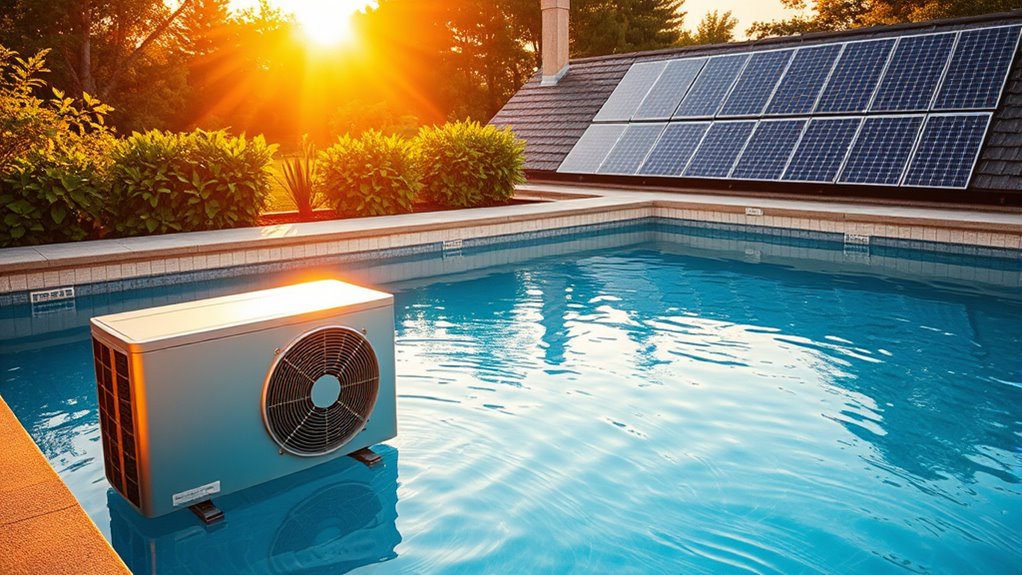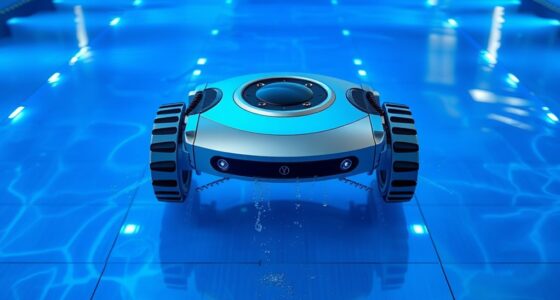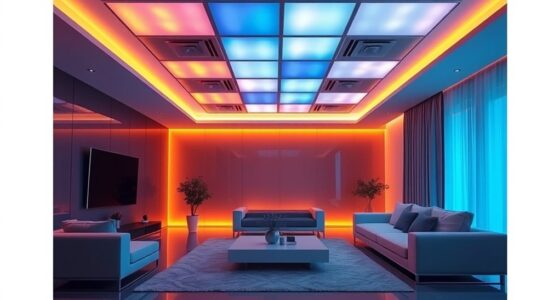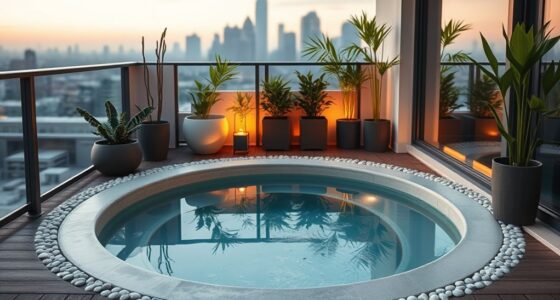To efficiently heat your pool, consider inverter heat pumps and solar options. Inverter heat pumps adjust their compressor speed to match your pool’s needs, providing quiet, adaptable, and energy-saving warmth. Solar systems harness the sun’s energy, reducing costs and environmental impact, especially when integrated with inverter models for better efficiency. Combining these methods can extend your swimming season and lower energy bills. Keep exploring to discover how these technologies can work best for your situation.
Key Takeaways
- Inverter heat pumps adjust compressor speed for efficient, quiet pool heating while reducing energy consumption.
- Solar pool heating uses sunlight to naturally warm water, lowering electricity costs and environmental impact.
- Hybrid systems combine solar and inverter heat pumps to optimize energy savings across different weather conditions.
- Proper system sizing and placement are crucial for maximizing solar collection and inverter heat pump efficiency.
- Regular maintenance enhances system performance, durability, and long-term energy savings.
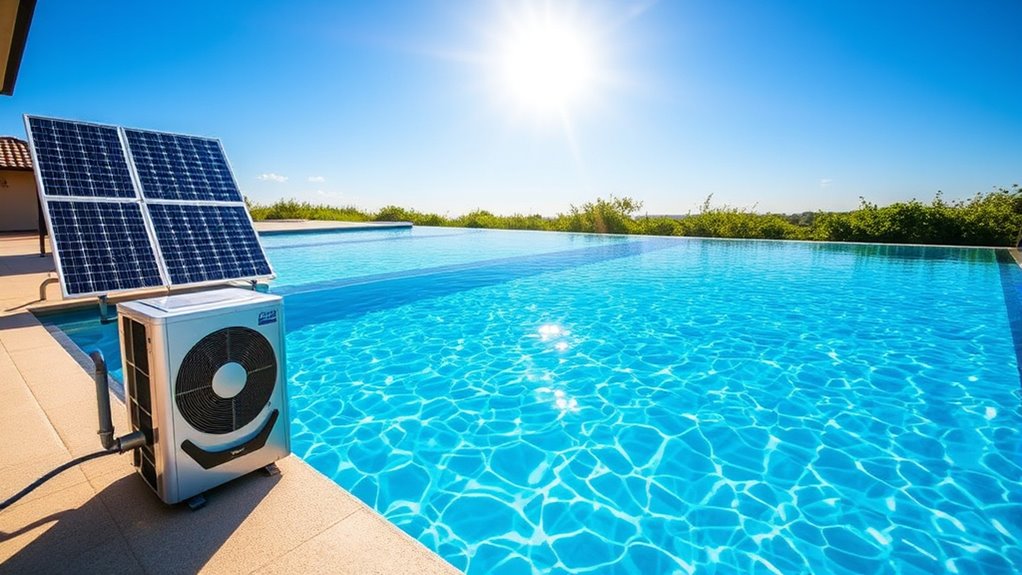
Are you wondering how to enjoy your pool year-round? If so, exploring energy-efficient pool heating options can make a considerable difference. Two popular choices are inverter heat pumps and solar-powered systems, each offering unique benefits. By understanding how these systems work and their key features, you can make an informed decision that saves you money and reduces your environmental footprint.
Inverter heat pumps are a smart upgrade from traditional pool heaters. Unlike standard models that operate at a fixed speed, inverter heat pumps adjust their compressor speed based on your pool’s temperature needs. This means they run more efficiently, consuming less energy while maintaining a consistent temperature. Their inverter efficiency allows them to ramp up when needed and slow down during milder weather, resulting in less energy waste and lower electricity bills. Additionally, inverter heat pumps tend to operate quieter than traditional models, providing a more peaceful outdoor experience. These systems are especially effective in moderate climates but can be paired with other heating methods for colder conditions.
Inverter heat pumps provide efficient, quiet, and adaptable pool heating for moderate climates.
Solar integration is another excellent way to heat your pool sustainably. Solar pool heaters use the sun’s energy to warm your water, considerably reducing energy costs over time. They typically consist of solar collectors installed on your roof or a nearby area that captures sunlight. The heated water then circulates back into your pool, providing natural warmth. When considering solar integration, it’s essential to evaluate your location’s solar exposure and the size of the collectors needed to meet your heating demands. While initial installation costs might be higher, the long-term savings on energy bills make solar a worthwhile investment. Plus, solar systems operate silently and produce no emissions, aligning with eco-friendly goals.
Combining solar integration with inverter heat pump technology can give you a versatile, energy-efficient setup. For example, during sunny days, your solar collectors can handle most of the heating, while the inverter heat pump steps in during cloudy weather or at night. This hybrid approach maximizes energy savings and ensures your pool stays comfortable year-round. Additionally, understanding the refrigeration cycle helps in choosing and maintaining efficient systems. When choosing your system, prioritize inverter efficiency ratings and proper solar integration to optimize performance and durability. Properly maintained, these systems can extend your swimming season and considerably cut your energy expenses.
Frequently Asked Questions
How Long Does It Take to Heat a Pool With Inverter Heat Pumps?
It typically takes 24 to 72 hours to heat your pool with an inverter heat pump, depending on the pool size and starting temperature. You’ll notice the pool temperature rising gradually as the inverter adjusts its speed for efficient heating. For faster heating, you can set the thermostat higher, but keep in mind that the heating speed depends on factors like ambient temperature and pool volume.
Are Solar Pool Heating Systems Effective in Cloudy or Rainy Weather?
Solar pool heating systems can surprisingly keep your pool warm even on cloudy or rainy days, thanks to their impressive solar efficiency. While they’re not miracle workers, they still harness diffuse sunlight to generate heat, making them more effective than you might think in less-than-perfect weather. So, don’t let a gloomy sky stop you—solar heating keeps your pool cozy, rain or shine, turning even gray days into perfect swimming weather.
What Is the Average Lifespan of Inverter Heat Pumps and Solar Pool Heaters?
Inverter heat pumps typically last 10 to 15 years, while solar pool heaters can withstand 10 to 20 years with proper maintenance. Your durability expectations depend on factors like usage and climate. Most brands offer warranty coverage of 5 to 12 years for inverter heat pumps and up to 15 years for solar systems. Regular upkeep helps maximize their lifespan and ensures reliable, energy-efficient performance.
Can These Systems Be Integrated With Existing Pool Equipment?
Back in the day, integrating new tech was a hassle, but now inverter heat pumps and solar systems easily mesh with your existing pool equipment. You’ll want to check system compatibility and consider installation logistics, ensuring your setup works smoothly. Most systems are designed for compatibility, but consulting a professional guarantees a seamless integration, so you enjoy energy savings without a hitch.
What Maintenance Is Required for Inverter Heat Pumps and Solar Heating Systems?
You’ll need to regularly maintain your inverter heat pump and solar heating system by checking system calibration and cleaning filters. Confirm the system is accurately calibrated for peak efficiency, and clean the filters to prevent debris buildup that can reduce performance. Additionally, inspect components periodically for wear and tear, and schedule professional check-ups annually to keep your pool heating running smoothly and efficiently all season long.
Conclusion
Choosing between inverter heat pumps and solar options isn’t just about saving energy—it’s about revealing a hidden potential for year-round comfort. Imagine a pool that’s always the perfect temperature, no surprises, no high bills. But which system truly offers the best balance of efficiency and sustainability? The answer might surprise you. Dive deeper into these options, and discover the secret to endless, cost-effective swimming. The choice is yours—are you ready to make it?
